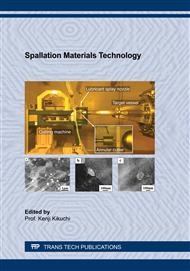[1]
H. Takada, K. Haga, M. Teshigawara, T. Aso, S. Meigo, H. Kogawa, T. Naoe, T. Wakui, M. Ooi, M. Harada, M. Futakawa, Materials and Life Science Experimental Facility at the Japan Proton Accelerator Research Complex I: Pulsed Spallation Neutron Source, Qnant. Beam Sci. 1 (2017) 8-1-26.
DOI: 10.3390/qubs1020008
Google Scholar
[2]
J. Haines, T. McManamy, T. Gabriel, R. Battle, K. Chipley, J. Crabtree, L. Jacobs, D. Lousteau, M. Rennich, B. Riemer, Spallation neutron source target station design, development, and commissioning, Nucl. Instrum. Phus. Res. A 764 (2014) 94-115.
DOI: 10.1016/j.nima.2014.03.068
Google Scholar
[3]
M. Futakawa, H. Kogawa, R. Hino, H. Date, H. Takeishi, Erosion damage on solid boundaries in contact with liquid metals by impulsive pressure injection, Int. J. Impact Eng. 28 (2003) 123-135.
DOI: 10.1016/s0734-743x(02)00054-4
Google Scholar
[4]
K. Okita, S. Takagi, Y. Matsumoto, Propagation of pressure waves, caused by a thermal shock, in liquid metals containing gas bubbles, J. Fluid Sci. Technol.3 (2008) 116-128.
DOI: 10.1299/jfst.3.116
Google Scholar
[5]
H. Kogawa, T. Naoe, H. Kyotoh, K. Haga, H. Kinoshita, M. Futakawa, Development of microbubble generator for suppression of pressure waves in mercury target of spallation source, J. Nucl. Sci. Technol. 52 (2015) 1461-1469.
DOI: 10.1080/00223131.2015.1009188
Google Scholar
[6]
H. Kogawa, T. Naoe, M. Futakawa, K. Haga, T. Wakui, M. Harada, H. Takada, Mitigation technologies for damage induced by pressure waves in high-power mercury spallation neutron sources (IV) – measurement of pressure wave response and microbubble effect on mitigation in mercury target at J-PARC –, J. Nucl. Sci. Technol. 54 (2017) 733-741.
DOI: 10.1080/00223131.2017.1309302
Google Scholar
[7]
T. Naoe, T. Wakui, H. Kinoshita, H. Kogawa, K. Haga, M. Harada, H. Takada, M. Futakawa, Cavitation damage in double-walled mercury target vessel, J. Nucl. Mater. 506 (2018) 35-42.
DOI: 10.1016/j.jnucmat.2017.10.044
Google Scholar
[8]
T. Naoe, H. Kogawa, T. Wakui, K. Haga, M. Teshigawara, H. Kinoshita, H. Takada, M. Futakawa, Cavitation damage prediction for the JSNS mercury target vessel, J. Nucl. Mater. 468 (2016) 313-320.
DOI: 10.1016/j.jnucmat.2015.08.035
Google Scholar
[9]
B. Riemer, D. McClintock, S. Kaminskas, A. Abdou, Correlation between simulations and cavitation-induced erosion damage in Spallation Neutron Source target modules after operation, J. Nucl. Mater. 450 (2014) 183-191.
DOI: 10.1016/j.jnucmat.2013.10.057
Google Scholar
[10]
H. Takada, K. Haga. Recent status of the pulsed spallation neutron source at J-PARC, JPS Conf. Proc., 28 (2020) 081003-1-7.
DOI: 10.7566/jpscp.28.081003
Google Scholar
[11]
H. Kinoshita, K. Haga, M. Seki, T. Suzuki, M. Ito, Y. Kasugai, T. Wakui, H. Kogawa, T. Naoe, K. Hanano, M. Teshigawara, F. Maekawa, S. Sakamoto, M. Futakawa, Development of cut out machine for PIE test pieces from mercury target vessel in J-PARC, Proc. 20th Int. Collaboration on Advanced Neutron Sources, Bariloche, 2012, Vol.1, pp.559-566.
DOI: 10.1016/j.jnucmat.2015.08.035
Google Scholar
[12]
M. Futakawa, T. Naoe, H. Kogawa, M. Teshigawara, Y. Ikeda, Effects of pitting damage on fatigue limit and lifetime in mercury target, J. Nucl. Mater. 356 (2006) 168-177.
DOI: 10.1016/j.jnucmat.2006.05.018
Google Scholar
[13]
T. Naoe, M. Futakawa, T. Oi, T. Wakui, Y. Motohashi, Fatigue strength degradation by pitting damage, J. Soc. Mater. Sci. Japan 55 (2006) 944-950.
DOI: 10.2472/jsms.55.944
Google Scholar
[14]
K. Haga, T. Naoe, T. Wakui, H. Kogawa, H. Kinoshita, M. Futakawa, Thermal hydraulic design of a double-walled mercury target vessel, JPS Conf. Proc. 8 (2015) 051008-1-6.
DOI: 10.7566/jpscp.8.051008
Google Scholar
[15]
M. Futakawa, H. Kogawa, S. Hasegawa, T. Naoe, M. Ida, K. Haga, et al., Mitigation technologies for damage induced by pressure waves in high-power mercury spallation neutron sources (II) -Bubbling effect to reduce pressure wave-, J. Nucl. Sci. Technol. 45 (2008) 1041-1048.
DOI: 10.3327/jnst.45.1041
Google Scholar
[16]
S. Kawamura, T. Naoe, T. Ikeda, N. Tanaka, M. Futakawa, Evaluation growing and collapsing behaviors of cavitation bubbles under flowing condition, Adv. Exp. Mech. 4 (2019) 33-37.
DOI: 10.1299/jsmeibaraki.2018.26.316
Google Scholar
[17]
T. Naoe, H. Kogawa, N. Tanaka, M. Futakawa, Pulsed pressure induced cavitation erosion in mercury narrow channel under flowing conditions, Adv. Exp. Mech. 4 (2019) 17-21.
Google Scholar
[18]
B. Vevera, D. McClintock, J. Hyers, B. Riemer, Characterization of irradiated AISI 316L stainless steel disks removed from the Spallation Neutron Source, J. Nucl. Mater. 450 (2014) 147-162.
DOI: 10.1016/j.jnucmat.2014.02.035
Google Scholar
[19]
D. McClintock, D. Bruce, R. Schwartz, T. Carroll, M. Dayton, D. Winder, Laser line scan characterization of cavitation-induced erosion to SNS mercury target vessels, ORNL/TM-2019/1103, (2019).
DOI: 10.2172/1492155
Google Scholar


